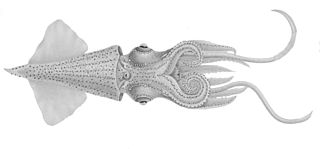
Ancistrocheirus lesueurii, the sharpear enope squid, is the only species in the genus Ancistrocheirus and family Ancistrocheiridae. With a mantle length of 25 cm (9.8 in), this moderately sized squid may be found throughout the tropical and subtropical oceans. They tend to be found at mesopelagic depths.

Enoploteuthidae is a family of squid comprising approximately 40 species in four genera. Most species have a mantle length ranging from 3–13 cm (1.2–5.1 in). Hooks are present on all arms and tentacles. The family is best known for the large array of photophores throughout the body.

Pyroteuthidae is a family of squids. The family comprises two genera. Species are diurnally mesopelagic, migrating into surface waters during the night. The family is characterised by the tentacles, which have a permanent constriction and bend near the base; and photophores occurring on the tentacles, eyeballs, and viscera. Members reach mantle lengths of 23–50 mm. Paralarvae of the family are common around the Hawaiian Islands, with up to 17% of collected specimens in the area belonging to Pyroteuthidae.

Abralia is a genus of squid comprising around 20 species from the family Enoploteuthidae. They are small squid which can be found in the epipelagic to mesopelagic zones while some species are found in water with shallow substrates on steep slopes on the boundary of the mesopelagic zone. They are distinguished from other members of the Enoploteuthidae by not normally having large, black photophores at the tips of arms IV, although if these are present they are not covered in black chromatophores, and having fins which extend beyond their tail. The photophores of the integument are characteristicand are found in the three types. "Lensed" photophores are a blue color with a white ring, "simple" photophores are small and violet-colored and the "complex" photophores are surrounded by small green satellite points and have a green centre. The complex photophores will frequently appear to be blue depending on their physiological state. The integument also has small black chromatophores which look like dots. They have 5–12 variably sized photophores on the eye. Either the right or left arm IV is hectocotylized.

Squid is eaten in many cuisines; in English, the culinary name calamari is often used for squid dishes. There are many ways to prepare and cook squid. Fried squid is common in the Mediterranean. In New Zealand, Australia, the United States, Canada, and South Africa, it is sold in fish and chip shops, and steakhouses. In Britain, it can be found in Mediterranean 'calamari' or Asian 'salt and pepper fried squid' forms in various establishments, often served as a bar snack, street food, or starter.

Enoploteuthis is a genus of squid in the family Enoploteuthidae. The species of Enoploteuthis are most easily recognised by having a larger tail when compared to the other genera in the Enoploteuthidae. The tail's size is emphasised by not having the fins extending along its sides. In related genera there is a narrow extension of the fins along the tail. Other characteristics include the presence of suckers on the distal portion of arms IV where there at no photophores present; the tentacular club has two rows of hooks and no marginal suckers; on the buccal crown there are typical chromatophores on the aboral surface but on the oral surface there may be some light skin pigmentation. They have 9-10 photophores on the eye and they have complex photophores in the skin. In the females the Spermatangia receptacles are at the posterior junction of muscles used to retract the funnel and the muscles which retract the head. Enoploteuthis differs from other genera of the Enoploteuthidae in having two rather than three types of photophores in its integument and these are on the ventral areas of the head, funnel and mantle. All species of Enoploteuthis which have been studied have the most complex type of photophoreand seems to be a distinctive characteristic of this genus. Enoploteuthis contains the largest species in the family, attaining a mantle length of 130mm.
Pyroteuthis margaritifera, the jewel enope squid, is a species of squid in the family Pyroteuthidae.

Abralia veranyi is a species of squid in the family Enoploteuthidae. Common names include the eye-flash squid, Verany's enope squid and the midwater squid. It is found in the Atlantic Ocean and the Mediterranean Sea. It undergoes a daily vertical migration from deep waters to near the surface.

Enoploteuthis leptura, the hooked enope squid, is a species of squid from the family Enoploteuthidae. It is the type species of the genus Enoploteuthis, which is in turn the type genus of the Enoploteuthidae.

Enoploteuthoidea is a superfamily of squid in the order Oegopsida.
Enoploteuthis jonesi is a species of squid from the family Enoploteuthidae. The species is gonochoric and can be found in the Pacific Ocean.
Enoploteuthis higginsi is a species of squid from the family Enoploteuthidae. The species is gonochoric, and can be found in the Eastern Pacific Ocean.
Enoploteuthis galaxias is a species of squid from the family Enoploteuthidae. The species has been observed off the coast of Tasmania.
Enoploteuthis octolineata is a species of squid from the family Enoploteuthidae. The species has been observed off the coast of Kiribati in the South Pacific Ocean.
Enoploteuthis magnoceani is a subspecies^ of Enoploteuthis leptura from the family Enoploteuthidae. Some authorities consider Enoploteuthis magnoceani as being its own species, and has been observed in the Indo-Pacific Ocean.
Enoploteuthis obliqua is a species of squid from the family Enoploteuthidae. The species is rarely documented, but has been observed in the North Pacific Ocean.
Enoploteuthis chunii is a species of squid from the family Enoploteuthidae. They have been observed off the coast of Korea.
Enoploteuthis galaxias is a species of squid from the family Enoploteuthidae. The species has been observed in the North Pacific Ocean.

Abraliopsis pfefferi, also known as Pfeffer's enope squid, is a species of squid from the genus Abraliopsis. The species has been observed in the North Atlantic Ocean.









